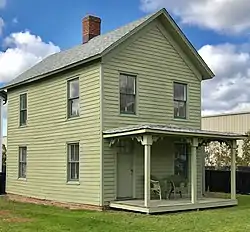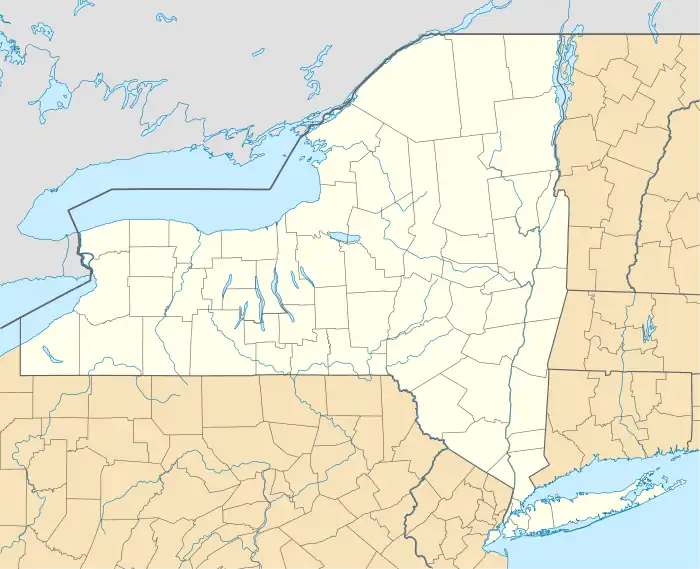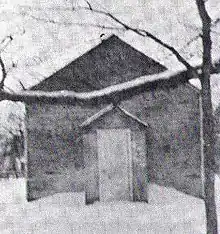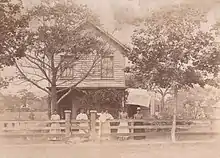Mary E. Bell House | |
 | |
 Location in New York  Location in United States | |
| Location | 66 Railroad Avenue, Center Moriches, New York |
|---|---|
| Coordinates | 40°48′13″N 72°47′24″W / 40.8035°N 72.7901°W |
| NRHP reference No. | 100005831 |
| Added to NRHP | November 13, 2020 |


The Mary E. Bell House is a historic house at 66 Railroad Avenue approximately 1/10th mile south of the Long Island rail road in Center Moriches, Long Island, New York. Built in 1872 by Selah Smith of Huntington who purchased the land, it is significant in the area of ethnic history for the Smith and Bell families and the African-American AME Zion community of Center Moriches during the nineteenth and twentieth centuries.[1] It was listed on the National Register of Historic Places in 2020.[2] It is under the Stewardship of the Ketcham Inn Foundation.[3]
History
Selah W. Smith was a farm hand and his wife Mary Ann was a laundress. They had five daughters, Alice, Ada, Ida, Mary E., and Hannah whom lived with their parents in 1880.[4] The expansion (Ca.1880) on the home was likely done to accommodate Mary's laundry business.[5] The family had maintained a garden on the land north of the house. The Smiths walked the short block south to attend the AME church, which had become the center of African-American worship in Center Moriches and drew congregants from surrounding hamlets. When pastor Abraham Perdue passed away in 1888 followed shortly thereafter by his wife, Mary E. Smith and Annie Arch of Manorville kept the small congregation going in the next decade.
In 1895, Mary E. married a day laborer, Ernest Bell of North Carolina,[6] and by 1900 the family with children Ethel, Alice and Lillian were the sole occupants of the house.
During the latter 1890s, Mary E. Bell became an adherent of the AME Zion's Varick Christian Endeavor Society, founded by James Varick in 1896.[7] His liberation of female roles in the Zion sect (Founded 1821) would play a pivotal role in the Center Moriches AME congregation. In 1897, the congregation would break from the AME to officially become African Methodist Episcopal Zion (AMEZ). The AME Zion was the first to ordain female elders and deacons, allowing female delegates to its conference in 1897 to vote for trustees.
Christian Endeavor societies, like the Y.M.C.A., were very popular during the late 1890s among Protestant denominations. Their progressive focus was on attracting and keeping young adults, mainly men, active in the life of the congregations and the community. Most of these Societies, (over 800 by 1902 comprising 20,000 youths.[8]) were run by women. Mary E. Bell would become the local leader of the Varick Christian Endeavor Society in Center Moriches from its beginnings as a co-ed social group with activities such as dinners, picnics and other service projects like food banks and providing educational assistance such as tutors and weekly bible classes.[9]
From the turn of the century until it closed in 1914, the small church was dependent on Mary Bell and Annie Arch for its survival, Ministers came and visited from the AME Zion and members were lost from various causes, relocations and deaths also contributed to its demise. Annie would in summer and winter come over from her farm in Manorville to worship with her friends and the remaining congregants. After it closed its doors, Mary bell continued to hold church gatherings in her house informally,[10] by 1915 her husband Earnest would become institutionalized and would remain so until his death in 1950. Mary and the girls, Alice (b.1898) and Lillian, with son Eugene (b.1902) were in the house in 1920 when the church's fortunes began to turn due to the great migration. African-Americans from the south had come to work on the farms of L.I. and the AME Zion sent a minister, Rev. William E. Wright, to take the reins of the congregation. When Mary Bell died, her beloved church took on a new name, the Bell AME Zion Church, so named in her honor.[11]
Alice Bell
Alice Bell, who was born at #66 Railroad Ave, would inherit the house from her mother. Between the 1920s and the 1950s she would figure prominently in the AMEZ church of Center Moriches as it grew and prospered. A trustee, she served on the Ladies Aid society and was prominent in the fundraising activities of the organization. When the church outgrew the elder building musical events were held to fund a new church, events that drew attendance from outside the congregation with dinners and other programs held at her house.[12] The 1847 church building was moved to 123 Railroad Ave. By 1954 she was also famous for her sweet potato pies, they would be her most prominent featured dish at gatherings and fundraisers for the rest of her life. Alice never wed, or drove an automobile, she lived a quiet life, active in her church and kept working as a housekeeper. She was honored by the church in her later years, ordained a Deaconess and elevated to membership in the Women's Home and Overseas Missionary Society,[13] a major outreach of the AME Zion church in the 1980s.[14]
Alice Bell died in 1996, the house was taken from the family for tax liabilities and legal wrangling caused it to become a deteriorating rental property for the next decade, for which demolition loomed in 2009.[15] The Bell AME Zion church advocated for it to be preserved and in 2011 the Town of Brookhaven passed a resolution designating the ‘’’Mary E. Bell house’’’ a historic landmark and took ownership of the property, working in partnership with the Ketcham Inn Foundation to formally reopen the house as a contributing property in the Center Moriches Historic District.[16] It opened as a historic site on June 22, 2019 and made available to the public as an event space.[17]
Landmark status
During its life, the house served the African-American community during a time when the local church closed its doors for a brief space and the house became the second home to the congregation in the integrated community. With the help of Bert Seides, a preservationist,[18] the house was proposed for historic preservation in 2011 by the Ketcham Inn Foundation,[19] which partnered with Brookhaven on its restoration, and now operates it as a special event space and museum.[20]
The Mary E. Bell House was declared a Brookhaven town landmark in 2011. It was listed on the National Register of Historic Places in 2020.[21][2]
See also
 New York State portal
New York State portal- National Register of Historic Places listings in Brookhaven, New York
- Terry-Ketcham Inn, another National Register site under the stewardship of Ketcham Inn Foundation
Further reading
- Field, Mary and Van. The Illustrated History of the Moriches Bay Area. Center Moriches, NY: Moriches Bay Publications, 1990.
References
- ↑ James T. Campbell, Songs of Zion: the African Methodist Episcopal Church in the United States and South Africa (Chapel Hill: University of North Carolina Press, 1998), 10–13; Day, 54; Henry H. Mitchell, Black Church Beginnings: the Long-Hidden Realities of the First Years (Grand Rapids, MI: Eerdmans, 2005), 82–3.
- 1 2 "Weekly listing". National Park Service.
- ↑ "KIFI". The Ketcham Inn Foundation.
- ↑ Federal Census, New York, 1880; F.W. Beers, “Center Moriches,” 1888; Photograph of the Mary E. Bell House, undated, collection of the Ketcham Inn Foundation
- ↑ This addition first appears on the 1888 map. F.W. Beers & Co, “Center Moriches,” in Atlas of the Towns of Babylon, Islip, and the South Part of Brookhaven in Suffolk County (New York: Wendelken & Co, 1888).
- ↑ Federal Census, New York, 1900; Wiese, Places, 5, 37, 68–69; The 1880 census records a 6-year old Ernest in the household of Edward Bell in Beaufort, Carteret, North Carolina. It is likely that this is the same person that traveled to Long Island and later married Mary E. Smith
- ↑ Irvine Garland Penn, The United Negro: His Problems and his Progress, Containing the Addresses and Proceedings of the Negro Young People’s Christian and Educational Congress, held August 6–11, 1902 (Atlanta: D.E. Luther Publishing Co., 1902), 542; Mitchell, Black Church Beginnings, 73.
- ↑ Sally G. McMillen, To Raise up the South: Sunday Schools in Black and White Churches, 1865–1915 (Baton Rouge, LA: Louisiana State University Press, 2001), 202; Penn, The United Negro, 67-8, 186, 542.
- ↑ Church, “History,” 9; Cicero Richard Harris and African Methodist Episcopal Zion Church, Historical Catechism of the A.M.E. Zion Church. For Use in Families and Sunday Schools (Charlotte, NC: AME Zion Publication House, 1922), 30.
- ↑ "Mary e. Bell House recommended for state, national historic registers". 17 September 2020.
- ↑ Church, “History,” 9; Cicero Richard Harris and African Methodist Episcopal Zion Church, Historical Catechism of the A.M.E. Zion Church. For Use in Families and Sunday Schools (Charlotte, NC: AME Zion Publication House, 1922),page 30.
- ↑ Bell A.M.E. Zion Church. “History of Bell A.M.E. Zion Church, 1847–1955.” Town of Brookhaven archives
- ↑ Campbell, James T. Songs of Zion: the African Methodist Episcopal Church in the United States and South Africa. Chapel Hill: University of North Carolina Press, 1998
- ↑ Willie Hill, “Save The Historic Bell House,” The Press of Manorville and The Moriches, May 15, 2010
- ↑ Winslow, Olivia (September 14, 2020). "Rich in Black history, Center Moriches home may become officially historic". Newsday.
- ↑ "Map of Center Moriches Historic District". www.brookhavenny.gov.
- ↑ Cathy Meinhold, “The Mary E. Bell House is progressing to historic preservation,” The Tide of Moriches, October 2014; Willie Hill, “Save The Historic Bell House,” The Press of Manorville and The Moriches, May 15, 2010; “History’s Heroes,” The Press of Manorville and the Moriches, May 7, 2010; Brookhaven Town Board, “Resolution of Adoption to Designate the AME Zion Bell House, also known as the Mary E. Bell House, as an Historic Landmark,” February 15, 2011.
- ↑ "Moriches and the Terry-Ketcham Inn". 8 October 2014.
- ↑ "Mary e. Bell House Nominated for Historic Designation". 16 September 2020.
- ↑ "New York State Board for Historic Preservation recommends 18 sites in NYS for 'Historic Place' designation". 14 September 2020.
- ↑ "Mary E. Bell House (National Register of Historic Places Registration Form)" (PDF). parks.ny.gov. Archived from the original (PDF) on 18 October 2020.

